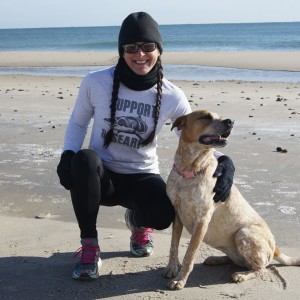 Cynthia Wigren co-founded the Atlantic White Shark Conservancy and the Gills Club. She holds a Bachelor of Science in Wildlife Management and a Masters in Business Administration. She is an avid traveller and a scuba diver with a deep appreciation for wildlife on land and sea. Her underwater experiences with whale sharks, great hammerheads, nurse sharks, and great white sharks led her to leave the corporate world and establish a non-profit to support shark research and education programs.
Cynthia Wigren co-founded the Atlantic White Shark Conservancy and the Gills Club. She holds a Bachelor of Science in Wildlife Management and a Masters in Business Administration. She is an avid traveller and a scuba diver with a deep appreciation for wildlife on land and sea. Her underwater experiences with whale sharks, great hammerheads, nurse sharks, and great white sharks led her to leave the corporate world and establish a non-profit to support shark research and education programs.
This year, Shark Week has promised us more science and no fake documentaries (thank you Rich Ross!), but their ‘Finbassabor’ line-up leads me to believe that the majority of researchers featured will be men, once again. As long as Shark Week ditches mockumentarties for real science does it matter which researchers it features? With 42 million people tuning in during the week, I believe it does.
It wouldn’t have occurred to me that the lack of females featured in Shark Week was an issue until I started a non-profit to fund shark research. At events, I met young girls that were being told by other kids that, “only boys like sharks” and being discouraged from following their passion. I realized that if your only experience with shark research/conservation is Shark Week – like it is for most kids – you may believe that shark science is a career only for men. The reality is, shark science is comprised of many women who live every week like it’s Shark Week. I wanted to find a way to connect the two groups, and so the Gills Club was born!
The Gills Club Science Team is an all-volunteer group of leading female shark & ray researchers and conservationists. Each month our Facebook group features two Gills Club scientists who share their research and personal experiences. They host Q & A sessions, notes from the field, and brilliant pictures of their research in action. Not only have these women contributed to over 400 peer-reviewed scientific publications on sharks and rays, they are donating their time and skills towards encouraging the next generation of elasmo-scientists and ocean conservationists!
“Membership and participation in the Gills Club empowered my daughter to transform a ‘C’ in sixth grade science on her first term report card into an ‘A-‘ for the second term. The Gills Club expanded her knowledge and passion for all things shark, introducing her to many other young female shark enthusiasts and scientists. Paige demonstrated the courage, curiosity, confidence and commitment to improve her grade,” -Bob Fiske
“Thank you for all that you do for The Gills Club and all the girls involved in the club! Maggie has so many true role models now, it’s such an encouragement to her! She believes she can really become a marine biologist, even though she is growing up in landlocked Colorado!” – Amy O’Connell
Shark Week defines a Finbassador as someone with a deep and undying passion for sharks and their continued survival. Here’s my line-up of female scientists that are wonderful Finbassadors:
Dr. Heather Marshall – Gills Club co-founder and event leader Florida @HeatherMPhD
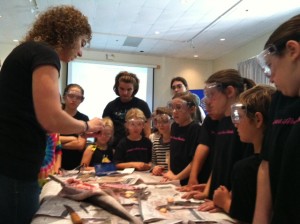 “I research the stress physiology that sharks experience when they are captured on fishing gear to try and determine what stress indicators may be correlated with mortality events. I assess such physiology by taking blood samples from sharks after capture, and measuring levels of certain potential stress indicators, such as lactate and pH levels. I also assess mortality rates associated with different forms of fishing, and specifically post-release mortality rates, by using different types of electronic tags to assess this important and often unaccounted for potential source of fishing mortality. The combination of this work allows us to correlate fishing mortality and physiological upset, and look for physiological reasons behind why sharks may experience mortality after capture. For example, my PhD research found that high blood potassium levels, called hyperkalemia, were a significant predictor of mortality in sandbar and dusky sharks. Why this may be the case still needs to be researched, but, it was exciting to potentially find a clear blood signal of mortality, and I will continue investigating this correlation during my work at Mote. Assessing mortality rates has a more obvious connection to shark conservation, because we can provide such data to be used in stock assessments and considered for fisheries management plans, leading towards improved management of impacted shark species. In addition, by performing the physiological investigations, we can start trying to understand why sharks are dying, which may give us some ideas about how we can further mitigate fisheries interactions to improve gear selection or handling practices, therefore increasing a shark’s ability to survive and recover from a capture event.”
“I research the stress physiology that sharks experience when they are captured on fishing gear to try and determine what stress indicators may be correlated with mortality events. I assess such physiology by taking blood samples from sharks after capture, and measuring levels of certain potential stress indicators, such as lactate and pH levels. I also assess mortality rates associated with different forms of fishing, and specifically post-release mortality rates, by using different types of electronic tags to assess this important and often unaccounted for potential source of fishing mortality. The combination of this work allows us to correlate fishing mortality and physiological upset, and look for physiological reasons behind why sharks may experience mortality after capture. For example, my PhD research found that high blood potassium levels, called hyperkalemia, were a significant predictor of mortality in sandbar and dusky sharks. Why this may be the case still needs to be researched, but, it was exciting to potentially find a clear blood signal of mortality, and I will continue investigating this correlation during my work at Mote. Assessing mortality rates has a more obvious connection to shark conservation, because we can provide such data to be used in stock assessments and considered for fisheries management plans, leading towards improved management of impacted shark species. In addition, by performing the physiological investigations, we can start trying to understand why sharks are dying, which may give us some ideas about how we can further mitigate fisheries interactions to improve gear selection or handling practices, therefore increasing a shark’s ability to survive and recover from a capture event.”
Dr. Mikki McComb-Kobza – Gills Club event leader Colorado @Mikki_Kobza
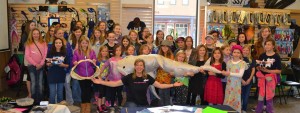 “Much of the research I conduct is aimed at reducing unintended shark mortality. If we can keep sharks that are not directly targeted off longlines and out of nets, that is a positive thing. I have also learned along the way that research is vital and if it is complemented with public outreach, all the better. So many people do not know sharks are in decline or that they have a staggering diversity of species exists. People need to know the truth about sharks and how they can help to spread a positive message about them.”
“Much of the research I conduct is aimed at reducing unintended shark mortality. If we can keep sharks that are not directly targeted off longlines and out of nets, that is a positive thing. I have also learned along the way that research is vital and if it is complemented with public outreach, all the better. So many people do not know sharks are in decline or that they have a staggering diversity of species exists. People need to know the truth about sharks and how they can help to spread a positive message about them.”
Nicole Nasby Lucas – Gills Club event leader California
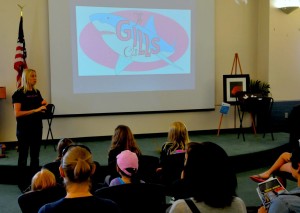 “My white shark tagging and tracking research provides information about where the sharks are going and what they are doing. My long term white shark photo-identification study helps to provide information on the status of the population by showing whether the population is increasing, decreasing or stable. All of this information is crucial for the successful management and conservation of northeastern Pacific white sharks.”
“My white shark tagging and tracking research provides information about where the sharks are going and what they are doing. My long term white shark photo-identification study helps to provide information on the status of the population by showing whether the population is increasing, decreasing or stable. All of this information is crucial for the successful management and conservation of northeastern Pacific white sharks.”
Dr. Michelle Heupel – Epic Gills Club Blogger & Scientific Communicator @MichelleHeupel
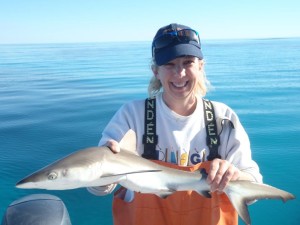
“My research benefits shark conservation by providing valuable information to managers. For example, my current research is designed to help Great Barrier Reef Marine Park managers understand whether reefs that are closed to fishing are protecting shark populations or if sharks moved too much between reefs to receive protection.”
Megan Winton – Gills Club event leader Massachusetts
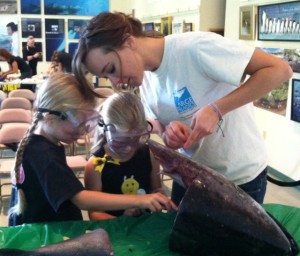 “Most of my work involves describing the aspects of shark and fish biology (age, growth, and reproductive biology) that form the basis of population models and stock assessments that are necessary to sustainably manage fisheries. It’s important to remember that fishermen aren’t the bad guys. They rely on the health of the oceans as well, and most of them want the same thing us scientists want, sustainably managed fisheries!”
“Most of my work involves describing the aspects of shark and fish biology (age, growth, and reproductive biology) that form the basis of population models and stock assessments that are necessary to sustainably manage fisheries. It’s important to remember that fishermen aren’t the bad guys. They rely on the health of the oceans as well, and most of them want the same thing us scientists want, sustainably managed fisheries!”
Dr. Laura Jordan-Smith – Gills Club event leader California
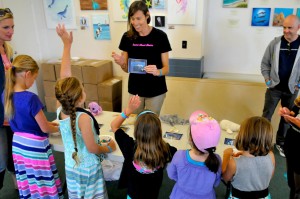 ”My work benefits shark and ray conservation through learning more about their behavior and sensory biology in order to reduce their accidental catch by fisheries. Bycatch reduction has become a major focus of improving fisheries management and is a serious concern for many shark and ray populations worldwide. Loss of animals as bycatch is the biggest threat for several species, including some at risk for extinction. Since many individuals don’t survive the stress of capture and handling even if they are released, it is important to focus on keeping them from being caught in the first place. Much of the bycatch reduction research with sharks and rays focuses on the electrosensory system, since bony fish targeted by most fisheries don’t have this sensory system and can’t detect the electric signals that sharks and rays can. So far, there seems to be a lot of variation in responses of different individuals and species, leaving a lot of room for future research to better understand these differences and how to alter fishing practices or fishing gear.”
”My work benefits shark and ray conservation through learning more about their behavior and sensory biology in order to reduce their accidental catch by fisheries. Bycatch reduction has become a major focus of improving fisheries management and is a serious concern for many shark and ray populations worldwide. Loss of animals as bycatch is the biggest threat for several species, including some at risk for extinction. Since many individuals don’t survive the stress of capture and handling even if they are released, it is important to focus on keeping them from being caught in the first place. Much of the bycatch reduction research with sharks and rays focuses on the electrosensory system, since bony fish targeted by most fisheries don’t have this sensory system and can’t detect the electric signals that sharks and rays can. So far, there seems to be a lot of variation in responses of different individuals and species, leaving a lot of room for future research to better understand these differences and how to alter fishing practices or fishing gear.”
Michelle Jewell – Gills Club Social Media Coordinator@ExpatScientist
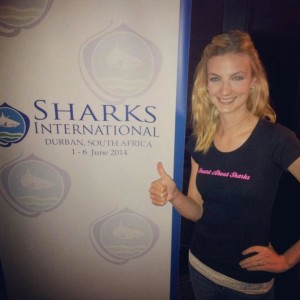 “My research has highlighted how important it is to study systems independently, no matter how similar they may appear to be. There are many seal colonies dotted along the coast of South Africa, and all of these colonies experience some degree of white shark presence during the winter, but what my study showed was that each system can still be very different. Seals and sharks near Shark Alley behaved totally differently to seals and sharks at nearby Seal Island, False Bay, so it is wrong to lump behaviours into a species specific bin (all white sharks do X all day every day). This is especially important for people who are trying to understand shark behaviour in order to limit shark/human encounters.” (Editor’s note, Michelle also writes for Southern Fried Science).
“My research has highlighted how important it is to study systems independently, no matter how similar they may appear to be. There are many seal colonies dotted along the coast of South Africa, and all of these colonies experience some degree of white shark presence during the winter, but what my study showed was that each system can still be very different. Seals and sharks near Shark Alley behaved totally differently to seals and sharks at nearby Seal Island, False Bay, so it is wrong to lump behaviours into a species specific bin (all white sharks do X all day every day). This is especially important for people who are trying to understand shark behaviour in order to limit shark/human encounters.” (Editor’s note, Michelle also writes for Southern Fried Science).
Helena Aryafar – Gills Club event leader California
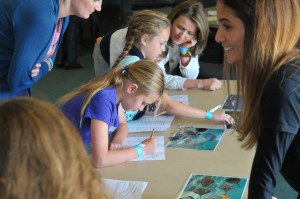 “Biological sampling and tagging of sharks can allow us to gain a better understanding of the where, when, and why of a shark’s behavior, which can contribute to management strategies to reduce overfishing, bycatch, and negative effects to the ecosystem.”
“Biological sampling and tagging of sharks can allow us to gain a better understanding of the where, when, and why of a shark’s behavior, which can contribute to management strategies to reduce overfishing, bycatch, and negative effects to the ecosystem.”
Lindsay Graff – Gills Club event leader Massachusetts
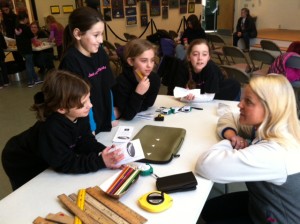 “I truly believe that the best way to make a meaningful impact with shark conservation is to focus on education and research, and that in most cases these two go hand-in-hand with each other. My shark biology courses that I lead in Fiji are full college courses that cover the gamut of everything from shark internal and external biology to threats that sharks face to recent research being done on sharks around the world. We spend every morning diving with the beautiful bulls, tigers, blacktip and whitetip reefs, grey reefs, tawny nurse sharks and sicklefin lemon sharks of Shark Reef Marine Reserve, which became Fiji’s first National Marine Park in November of 2014. It is incredibly important to me that my students assist with all the research being done by Beqa Adventure Divers, while gaining a life-long love and appreciation for sharks. Some of them will go on to become shark biologists or marine biologist in the future, but even the ones who pursue careers outside of the science realm, will still carry with them the necessary knowledge to educate others about the importance for shark conservation throughout the rest of their lives. Along with working on bull shark research (with this data on shark populations and migration patterns being integral to the creation and designation of the SRMR Marine Park), I try to split my time between being a shark biologist and an educator. I have such a passion and respect for sharks, that I want to share that with others in hopes that some of it will rub off on them, and then the sharks will have a few more advocates in their corner who appreciate them as much as I do!”
“I truly believe that the best way to make a meaningful impact with shark conservation is to focus on education and research, and that in most cases these two go hand-in-hand with each other. My shark biology courses that I lead in Fiji are full college courses that cover the gamut of everything from shark internal and external biology to threats that sharks face to recent research being done on sharks around the world. We spend every morning diving with the beautiful bulls, tigers, blacktip and whitetip reefs, grey reefs, tawny nurse sharks and sicklefin lemon sharks of Shark Reef Marine Reserve, which became Fiji’s first National Marine Park in November of 2014. It is incredibly important to me that my students assist with all the research being done by Beqa Adventure Divers, while gaining a life-long love and appreciation for sharks. Some of them will go on to become shark biologists or marine biologist in the future, but even the ones who pursue careers outside of the science realm, will still carry with them the necessary knowledge to educate others about the importance for shark conservation throughout the rest of their lives. Along with working on bull shark research (with this data on shark populations and migration patterns being integral to the creation and designation of the SRMR Marine Park), I try to split my time between being a shark biologist and an educator. I have such a passion and respect for sharks, that I want to share that with others in hopes that some of it will rub off on them, and then the sharks will have a few more advocates in their corner who appreciate them as much as I do!”
With all of the improvements promised for 2015’s Shark Week, I do hope that Rich Ross plays close attention to this blog and that 2016 will feature the much more diverse and exciting reality of modern shark science.